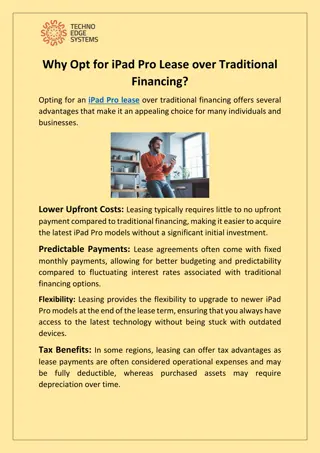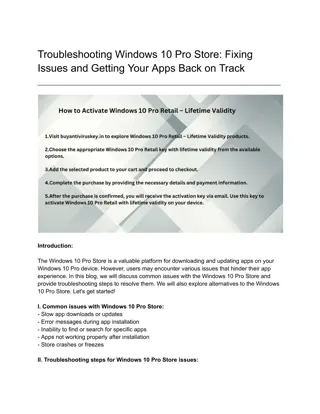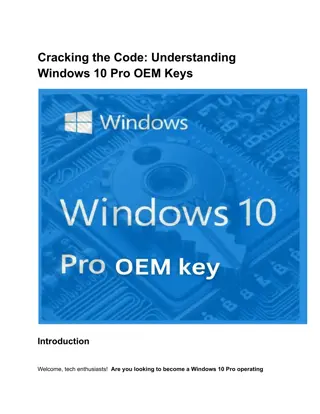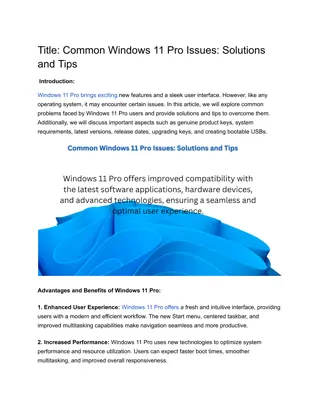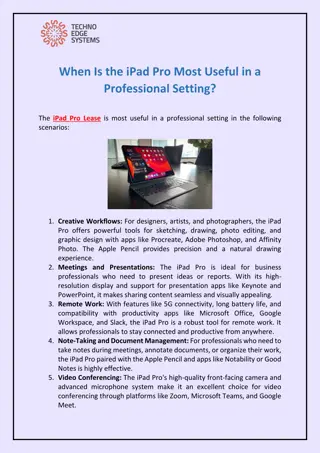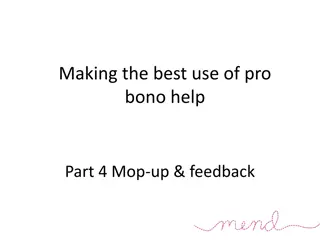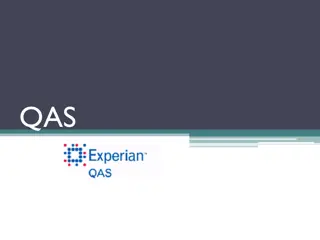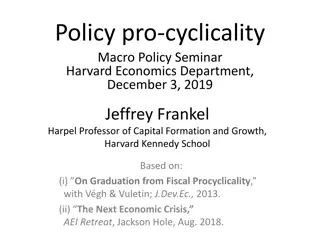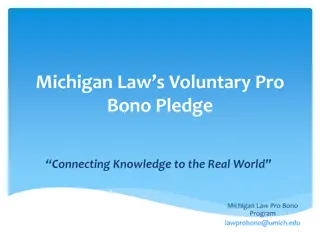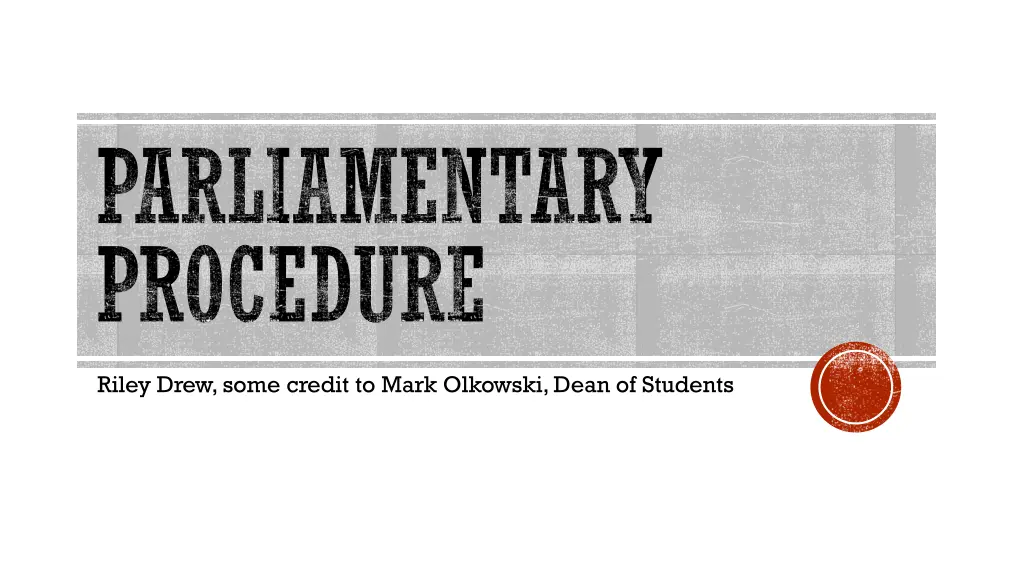
Parliamentary Procedure: Rules, Motions, and More Explained
Discover the ins and outs of parliamentary procedure, including its importance in running meetings efficiently, handling various types of motions, and utilizing incidental motions effectively to ensure smooth proceedings. Learn how to make motions, interrupt discussions, and engage in constructive debate following established guidelines.
Download Presentation

Please find below an Image/Link to download the presentation.
The content on the website is provided AS IS for your information and personal use only. It may not be sold, licensed, or shared on other websites without obtaining consent from the author. If you encounter any issues during the download, it is possible that the publisher has removed the file from their server.
You are allowed to download the files provided on this website for personal or commercial use, subject to the condition that they are used lawfully. All files are the property of their respective owners.
The content on the website is provided AS IS for your information and personal use only. It may not be sold, licensed, or shared on other websites without obtaining consent from the author.
E N D
Presentation Transcript
PARLIAMENTARY PROCEDURE Riley Drew, some credit to Mark Olkowski, Dean of Students
WHAT IS IT? Rules to run a meeting. Based off of Robert s Rules of Order Newly Revised Currently on its 11thedition Original authored by General Henry M. Robert III in 1876
WHATS THE POINT OF PARLI PRO? Can feel overbearing sometimes, but it is a necessary evil. It is important that the will of the majority prevails, but the minority is heard. Helps it so only one subject is handled at a time. Makes meetings go faster.
MOTIONS Parliamentary procedure is almost entirely handling a motion. A motion is a suggestion that the assembly do something Different types: Main motions Ex: a motion to approve a resolution or a funding request. Subsidiary motions Ex: a motion to amend the main motion, or to amend an amendment to the main motion Privileged motions Ex. Motion to adjourn or to recess Can interrupt a main motion or subsidiary motion. These aren t really used by us that often, except at the end of the meeting or to move to recess.
MOTIONS CONT. Incidental Motions Point of Order Point of Information NOT to be used to offer information, but only to request it. Point of Personal Privilege Point of Parliamentary Inquiry Call for Orders of the Day You can interrupt whoever has the floor or the chair with these. Do not need to be seconded or voted on and will be responded to immediately by the Chair or the otherwise applicable person. These are VERY useful as a voting member. Don t hesitate to use them! But do not overuse them, as interrupting frequently without a good reason can be rude.
MOTIONS CONT. PT. 2 Motion to Reconsider May only be moved by a person who voted on the prevailing side of a motion. The person who seconds this does not need to have been on the prevailing side, however. Takes precedence over all other motions. Not all motions can be reconsidered. Not debatable and must be voted on immediately. If a motion to reconsider is adopted, the original motion is immediately brought back before the assembly. Amendments Should generally be constructive and germane. No poison pill amendments that simply seek to destroy it. Friendly amendments NOT ALLOWED. Instead, ask for unanimous consent to amend the motion.
MOTIONS CONT PT. 3 After moved and seconded, a motion should be stated by the Chair in this way, or like fashion: It has been moved and seconded to XYZ. Is there any discussion?
DEBATE Need to be recognized by the Chair first. Raise your placard to do this. Try to avoid mentioning speakers by name. Obviously, avoid name-calling or assuming individuals have bad intentions. Avoid side-conversations or anything that might disrupt the meeting. If you need to leave early, please either ask permission beforehand or rise to a point of privilege and ask permission to leave. You can only speak twice (points of order, etc are not counted in this).
VOTING All voting members are entitled to one vote. They can vote in favor, against or they can abstain from voting. To abstain, you should generally have a good reason to. You can always change your vote, but you need to do so before the result of the vote is announced by the Chair. To do so, you can interrupt and declare your intention to do so. The Chair should ALWAYS restate the motion before putting it to the assembly.
TYPES OF VOTING Voice vote (viva voce) Rising Roll-Call Ballot We don t do some of these but you can always make a motion to change the voting method. Unanimous consent Chair can ask for unanimous consent to approve things of a non-controversial nature. You can do the same by saying Consent! The Chair will then ask for unanimous consent, and if there is no objection, the motion will carry.
COMMITTEE OF THE WHOLE Committee of the Whole, an important parliamentary device which we should use more! Relaxes rules on debate. Allows conversation to flow freely. No need for recognition by chair. Should be made like this: I move to consider the matter of xyz in committee of the whole. After this motion adopted, the assembly moves to committee of the whole. They generally should come to some consensus. Does not need to go into minutes, other than that the assembly went into committee of the whole. After exiting it, the Chair resumes meeting, and the Chair reports what the committee of the whole decided. A non-voice vote should be taken in committee of the whole it pertains to things that require 2/3rds majority or money.
SUFAC OFFICERS Chair: Does not vote unless there s a tie. Appointed by the SGA President for an indefinite term. Vice Chair: Votes. Elected by SUFAC at the end of each year. Chair and Vice Chair form the SUFAC Executive. Vice Chair Pro Tempore: Fills in for Vice Chair and/or Chair as needed. Administrative Assistant: Takes minutes, calls roll, etc.
SUFAC MEMBERS Voting Vice Chair Maximum of 8 Senators from SGA, including the Speaker of the Senate. All are appointed by Speaker. Maximum of 8 At-Large Members from the general student body, approved by the committee. One each from the Pride Center, MESA, OIE, Veterans Services and Athletics. Any former SUFAC Chairs or Vice Chairs still at the university are automatically entitled to membership. Non-Voting Chair Administrative Assistant (if not also a voting member). President and/or Vice President of SGA Advisers
SUFAC PROCEDURES We have guidelines that we use to determine whether we can approve a request or not. Exceptions can be granted to these guidelines. Must be approved by 2/3rds vote. Generally only given if a request is deemed essential to an organization, or we otherwise don t like the guideline in the first place. You are allowed 1 unexcused absence and 4 excused absences in the year. If you are going to be absent, please let us know at least 24 hours in advance! You cannot vote on things that you were not present to hear the presentation for.
ORGANIZATIONAL RULES SGA is organized similarly to the US government, though there are some differences.







